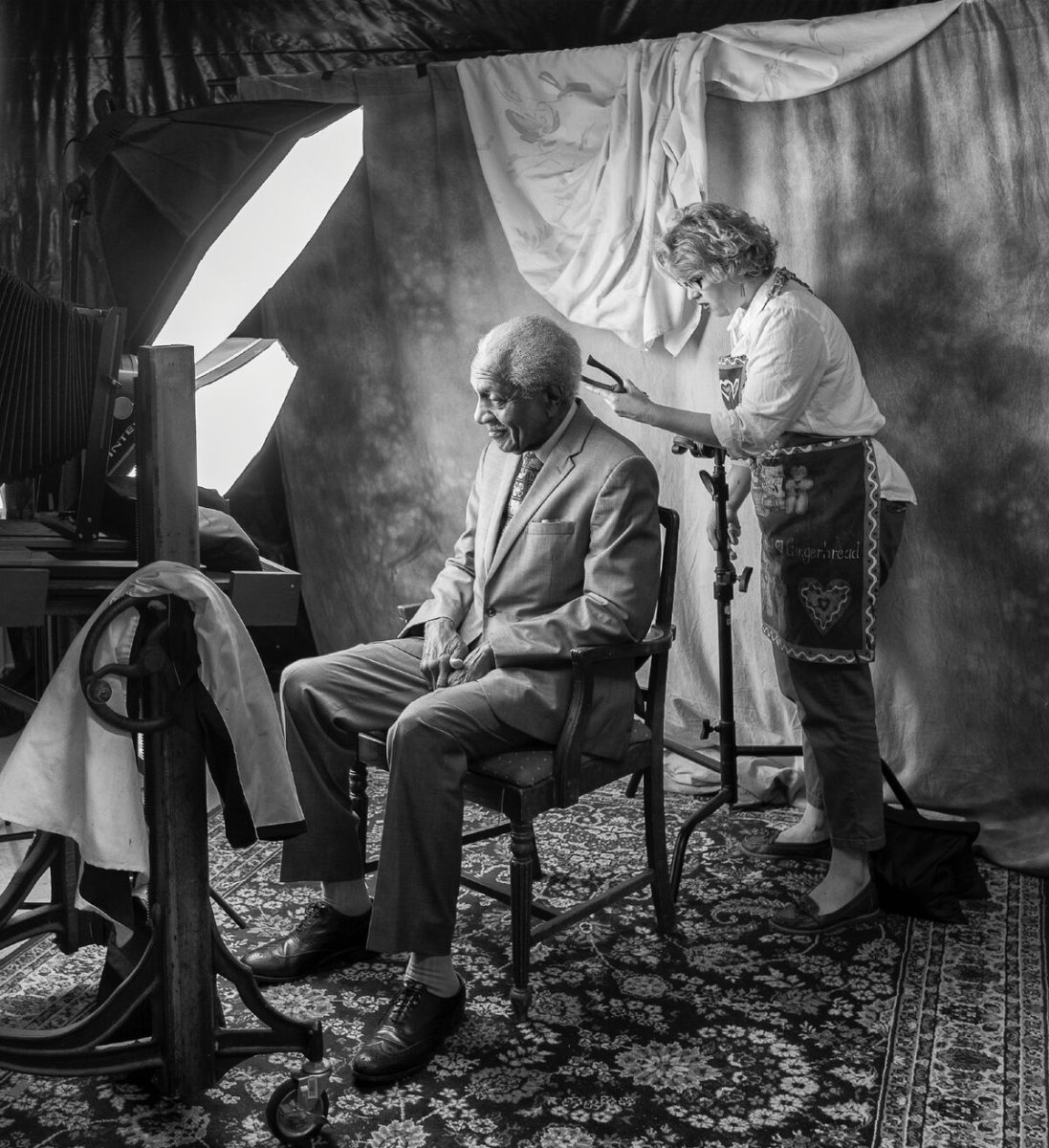Professor’s sabbatical portrait project challenges Southern stereotypes
In a photo taken by her husband, who served as an assistant during the project, Professor Kathryn Mayo preps one of her subjects, F.D. Reese, before taking his photo as part of her sabbatical portrait project “We Are Selma.”
In the small town of Selma, Alabama, they follow the motto, “From civil war to civil rights and beyond.” But one professor’s sabbatical project has brought a new theme into the spotlight: unity.
Photography Professor Kathryn Mayo traveled to her hometown of Selma, which she chose as the location for her sabbatical project.
“We Are Selma: The Portrait Project,” showcases the town’s residents with the hope of showing who they really are.
“I’m hoping that when people see this that they’ll see diversity and identity and a connection to home and the fact that this person’s white and this person’s black and this person’s old and this person’s young they really have the same values and are working towards the same goal,” said Mayo.
Ruth Shaw, one of the people that Mayo had photographed for the project, said in an email that she admired how Mayo was able to address difficult things but in a way that helped the people of Selma.
“Kathryn was very careful to include a variety of people; different races, different ages, different religions,” said Shaw. “Race is still a major stumbling block here in Selma, but this project crossed that barrier and helped all of us involved in the project feel proud of Selma. Selma needs to realize that it can be defined by its past, its present, and by things yet to come. Kathryn’s project helped us talk about ‘now’.”
As a native of Alabama, Mayo said that she realized there was a misconception about people from Selma that she hadn’t realized before.
With her project, she hoped she could show Selma from a different point of view.
“I gave people a way to contribute to how their identity was being portrayed, which I think is really important,” Mayo said. “It’s very important for you to have control over how you’re being portrayed, how somebody sees you or how comfortable you are with how somebody sees you portrayed.”
Mayo used a unique form of photography called the wet plate collodion process to create her images. She said that using this process that was used in older times really connected her project to Selma’s history, but the process is long and involved, so it also gave Mayo the chance to connect to the people she was photographing and also connect them to each other.
Photography Professor Patty Felkner, who was a part of the committee that awarded Mayo her sabbatical, admired Mayo’s approach to the project and how it “ties her past to her present.”
“I really love that it’s about civil rights,” said Felkner. “Even though the march on Selma happened 51 years ago, there’s so much going on right now in the United States that kind of echoes those days, so I felt like it was really timely.”
While photographing her subjects, Mayo conducted interviews where she would ask them about themselves and their connection to Selma. At the end of each interview she would ask them “what is your hope for Selma?” and said that everyone, in one way or another, answered “unity.”
“I think that’s what people are trying to work towards, but they don’t know how to get there,” Mayo said. “So, I was hoping that by talking to people when I was photographing them, that I could plant seeds or make connections.”
In the end, Mayo’s hope for the project was that Selma can be seen as it really is, not what it’s stereotypes define it as.
“It’s too bad that there are still those stereotypes; it’s too bad that there are people that perpetuate those, that do the things that cause those stereotypes to be perpetuated, but, for me, it seemed like the people there want change, they’re just trying to figure out how to get there,” Mayo said.
“I hope that they’ll see that people in those areas are really working to make it a better place, that people in those areas are individuals and that they’re thoughtful and resourceful and they are interested in moving forward.”
Head of the Photography Department, Professor Jim West, also commended Mayo on her project and discussed the importance of sabbatical projects for faculty.
“I think that, if you’ve been on a campus long enough, you lose touch with the outside,” said West. “Especially us as photographers, we lose touch with the industry, we lose touch with what’s going with the outside and I think a sabbatical provides the opportunity for us to reconnect professionally.”
West also expressed his admiration for Mayo as not only a professor, but as an artist.
“I think that Kathryn is a strong force in our department and I think she’s hasn’t peaked,” West said. “I think that she is on her way to creating more memorable work and that’s she’s got a long, healthy career ahead of her.”

